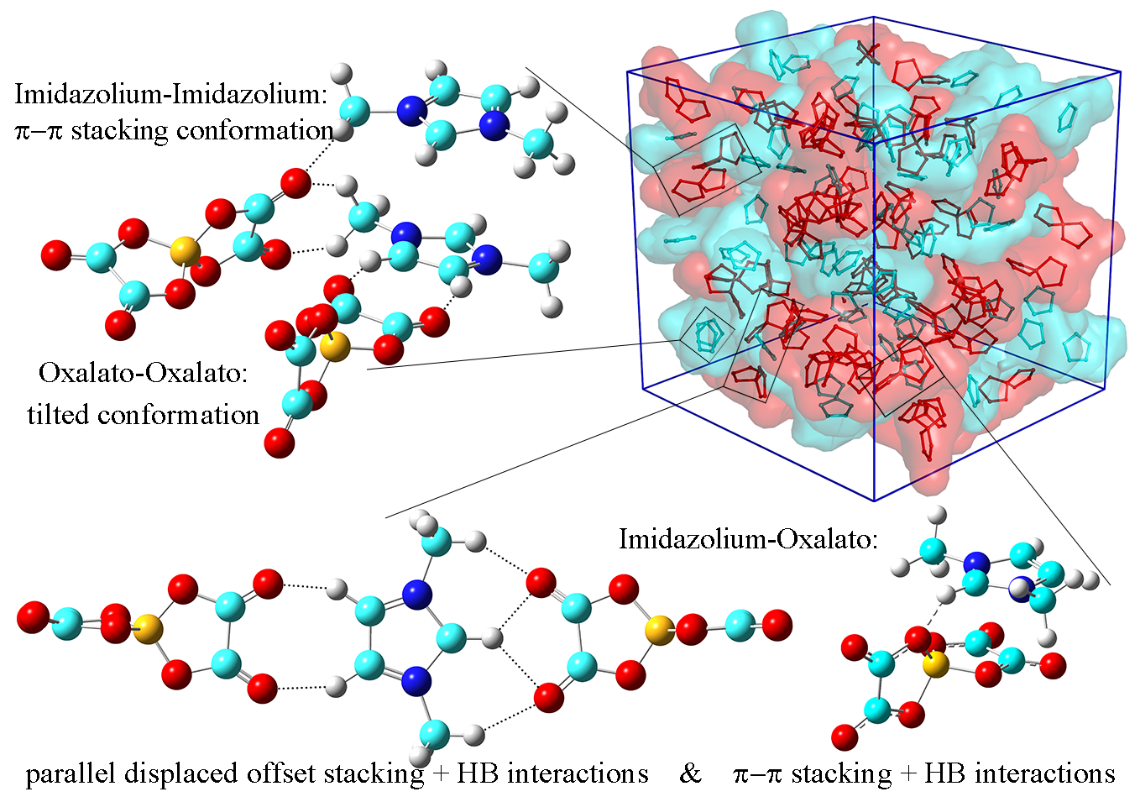Hydrogen Bonding vs. π-π Stacking Interactions in Ionic Liquid Simulations
Delicate intermolecular features like hydrogen bonding (HB) and π-type interactions play pivotal roles in stabilizing molecular structures in ionic liquids with planar rings and hydrogen-bond donors and acceptors. However, the nature of these interactions is distinctive and complex, and sometime has opposite effects on ionic structures. HB is mainly determined by covalent, electrostatic, and charge-transfer interactions, and is a key driving force for local structuring and dynamics in liquid phases, whereas π-type interactions are related to electrostatic and dispersion interactions only, and play essential roles in molecular recognition among ionic species. The trade-offs between these molecular interactions can give rise to strikingly liquid phase behavior of ionic liquids depending on specific ion types.
For imidazolium cations coupled small anions, like Cl−, SCN−, and NO3−, these anions can simultaneously promote HB and π-type interactions and the formation of prominent ordered microstructures in bulk ionic liquids. However, large anions, like bis(trifluoromethylsulfonyl)imide (NTf2−), typically have multiple HB interaction sites and thus exhibit reduced HB strength and directionality. Additionally, large anions take preferential on-top distributions above and below imidazolium rings, leading to π-type interactions partially or totally blocked due to anionic size effect. When imidazolium cations are coupled with anions featuring ring structures, like chelated orthoborate families, the delicate interplay of HB and π-type interactions among ionic species, either competitive or cooperative, becomes more complicated than this intuitive explanation implies.

Figure 1.
In a recent work, we performed ab initio molecular dynamics simulations to reveal competitive and cooperative characteristics among HB and π-type interactions in a typical imidazolium-oxalatoborate ionic liquid. Imidazolium rings take preferential on-top parallel orientations, leading to their particular π-π stacking distributions at short distances, as shown in panel in upper left corner in Figure 1. Intermolecular interactions of imidazolium and oxalato rings are characterized by on-top π-π stacking orientations (panel in lower right corner in Figure 1) and parallel displaced offset stacking conformations (panel in lower left corner in Figure 1) at short distances, and by sharp perpendicular distributions at intermediate distances, respectively. The former is stabilized by directional in-plane HB interactions between hydrogen atoms in imidazolium rings and oxygen atoms in oxalate rings, while the latter is dominated by attractive Coulombic interactions between ionic species. Spatial coordination patterns between intermolecular oxalate rings are balanced by repulsive electrostatic interactions and steric hindrance effects, leading to their tilted orientations in coordinating neighboring imidazolium cations in local ionic environment, as shown in panel in upper left corner in Figure 1.
Relevant Publications
467. "Hydrogen Bonding vs π-π Stacking Interactions in Imidazolium-Oxalatoborate Ionic Liquid," Yong-Lei Wang, Aatto Laaksonenb, and Michael D. Fayer J. Phys. Chem. B 121, 7173-7179 (2017).
